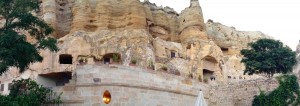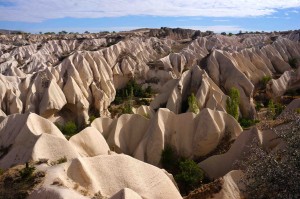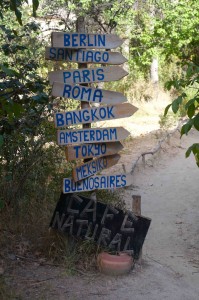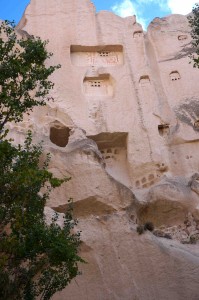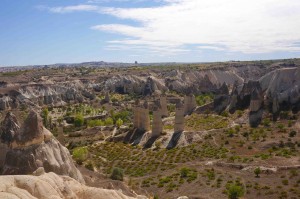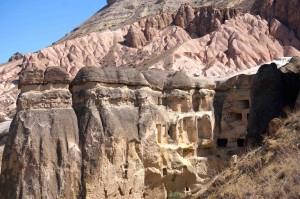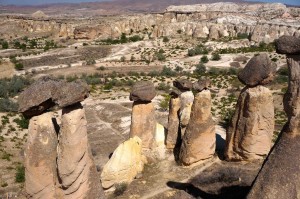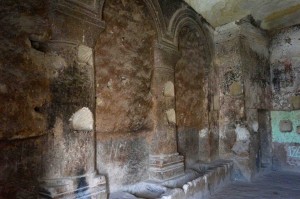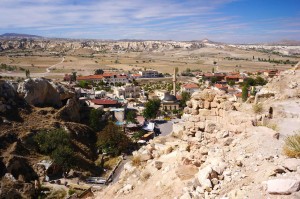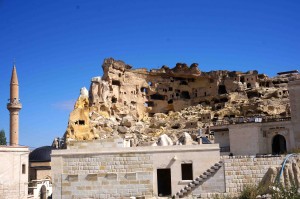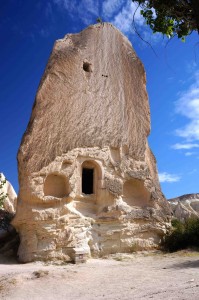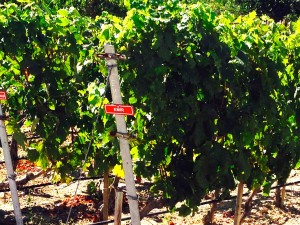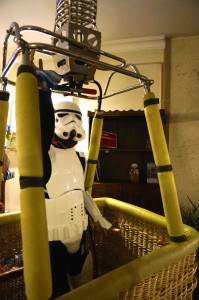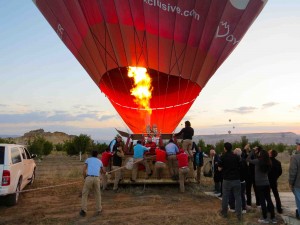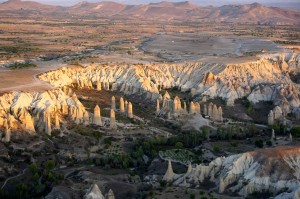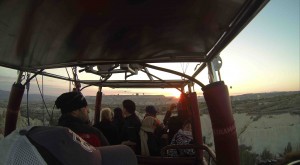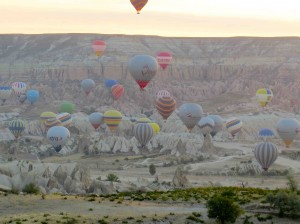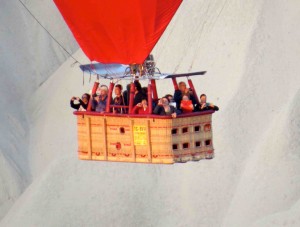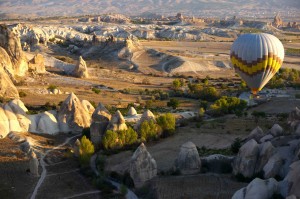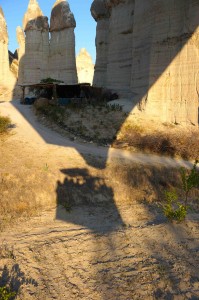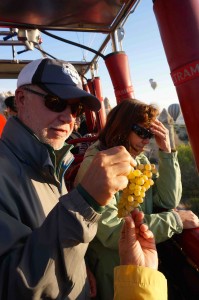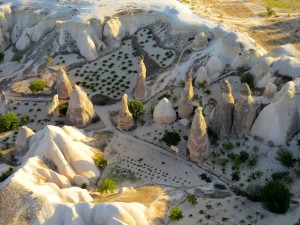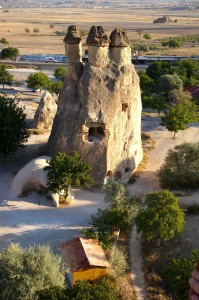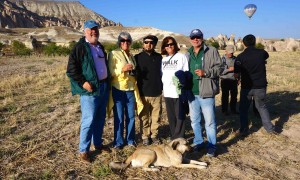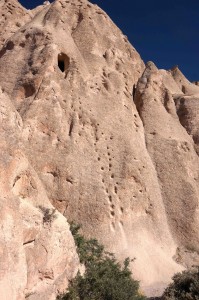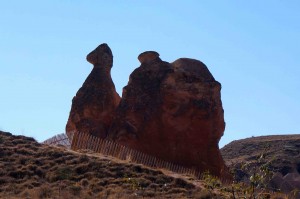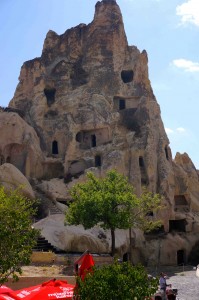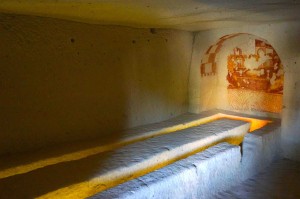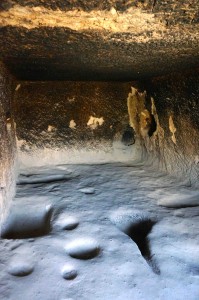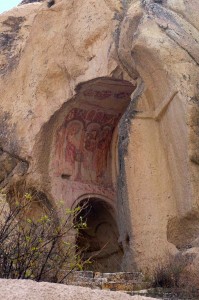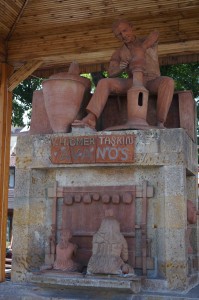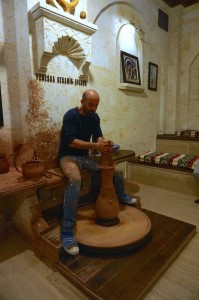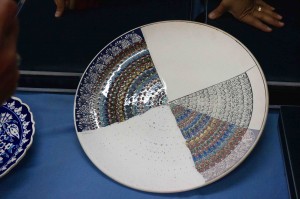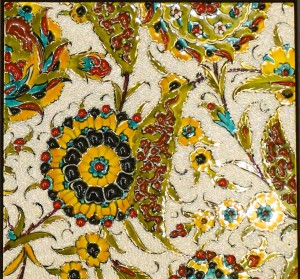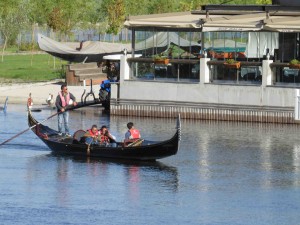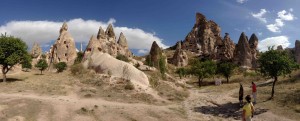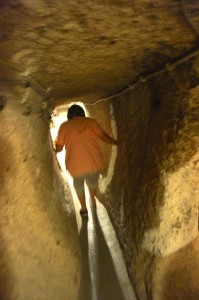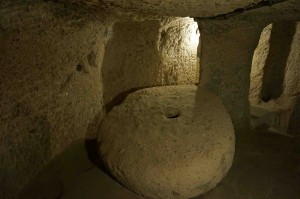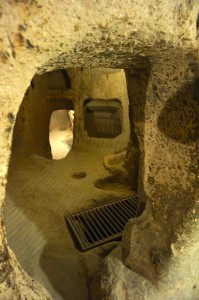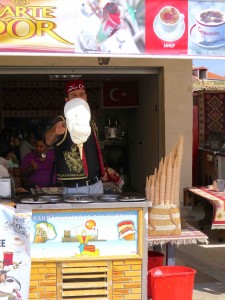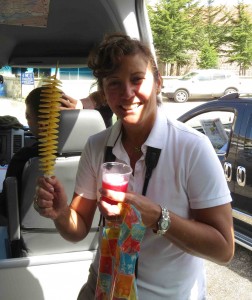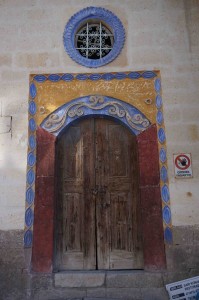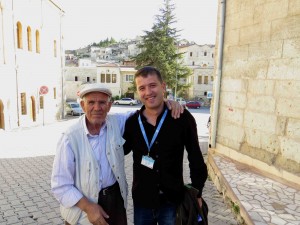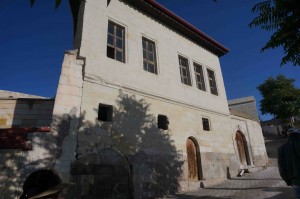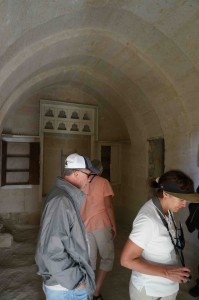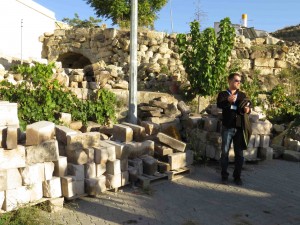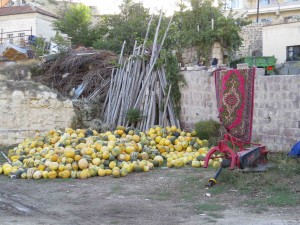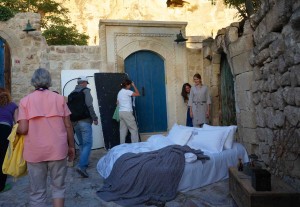This part of the trip marked the shift from Croatia to Turkey to visit the region of Cappadocia. Although the physical distance isn’t that great, getting there was somewhat of a challenge, requiring flight changes (and long waits) in Zagreb and Istanbul and then an hour van ride from Kayseri, Turkey.
Cappadocia is almost dead center within Turkey. It isn’t a place; rather it is an ancient regional name that covers a lot of territory and towns. The history of the area is a volcanic one – there were several volcanoes that were active, starting 10 million years ago all the way to the present day (Mount Erciyes still dominates the scenery and is active). All of the rock formations that make up the valleys around Cappadocia aren’t made of limestone or sandstone (which we guessed), but rather layer upon layer of volcanic tufa that was eroded by both water and wind over the millennia. In fact, it’s easy to see the volcanic layers and fault lines the created the individual rock formations and the impact of erosion in the formations called “fairy chimneys” that dot the area. They look like some combination of Gaudi sculptures, phalluses, and some bizarre Smurf Village. The other amazing thing is how residents used (and continue to use) these structures for housing, churches, etc. by carving into the tufa. It’s not entirely certain when this practice started, but settlements in the area go all the way back to 3000 BC (more of this later).
To get into the Cappadocia flow, we decided to stay in one of the many cave hotels (the ancient caves are refurbished and turned into rooms. It was quite an experience staying in a cave room but, as you might imagine, it can be a bit dank and there are only a couple of tiny windows. They were quite luxurious, but I think this is a “one time experience.” Unfortunately, on our first evening, both Deb and Alma got a rather bad case of food poisoning, resulting in Alma being down during the next day, and Deb being down for most of two days. The good news is that we saved the best things for last.
On the first day, Ken and I took a hike with our guide, Ramazan, several miles through the Rose Canyon (so named because some of the rock formations have a reddish color). In some respects, it reminded me of hiking through the Garden of the Gods in Colorado Springs. The valley is on private land and it isn’t unusual to see small farms, artisan shops, etc. out in the middle of nowhere. What are most noteworthy are the carved niches in the rock formations. At first we thought they we were graves or possibly dwellings, but they are called dovecoats – i.e., pigeon houses (a regular Petra for pigeons!). There are thousands of them! Why so many you ask? Did they eat a lot of pigeon? No! They kept pigeons for their poop – apparently a very rich fertilizer. In fact, they would feed the pigeons grain three times per year and then climb in and collect the harvest once per year (isn’t that a job you would love to have?!). They chose pigeons (rather than some other animal) to produce this pungent product because the feed to poop ratio is quite attractive. Anway, after the hike we went to the abandoned Cave City that is largely a ruin since the face of the city collapsed in an earthquake. As was the case of many other carved dwellings, each successive culture that used the caves altered them to their own needs. A good example was in the cave city where a former church carved out of the stone by the Byzantines was turned into a cattle feed lot by the conquering Muslims. We then did a quick stop to admire the panoramic view of Love Valley (known locally as Monica Lewinsky Valley – when you see the picture, you’ll get it). All of that walking and climbing really parched us, so Ken and I did a little wine tasting. While most of the wines weren’t all that inspiring, one local white wine, made of a local grape (Emir) was very nice (somewhere between a Pinot Gris and Sauvignon Blanc).
On our second day, Alma was mostly back to normal, but Deb was still somewhat under the weather. Despite that, she rallied to join us for the balloon trip over the Cappadocia area. In order to be up in the air for sunrise, we had to leave at 4:30 am. We ended up with a 30-minute delay for high winds, but ultimately lifted off for an amazing trip. Our pilot was really talented, bringing us up and down through the various canyons (even settling a few feet off the ground in a narrow canyon to pick up some grapes grown there). What is really amazing is that there are up to 100 balloons in the air at the same time. We actually saw some balloons collide! After the balloon ride, Deb headed back to bed and the rest of us continued on for the day. We first hiked through Imagination Valley that, in addition to all the fairy chimneys has lots of animal-shaped formations (e.g., a camel, snake, seals, dolphins) as well Mary holding Jesus. Okay, so some of these were fairly obvious and some probably required heavy doses of “wacky tobacky” before you could see them. From there, we went to the Goreme Open Air Museum, originally a Christian community carved into the rock formations, probably starting in the 2nd century AD and hitting its peak around the 4th Century AD when Saint Basil was busy starting churches in the area. This was really a religious education center, filled with churches, monasteries, convents, open-air classrooms, etc. The frescoes (that you aren’t allowed to take pictures of) were still in amazing shape given their age and numbers of non-Christians that lived there in later years. From there, we visited Avanos, a small town that has been known for its pottery making since the time of the Hittites. Everything is still done by hand and the surface decoration is wickedly complex and stunningly beautiful. As you might suspect, this was an opportunity for some retail therapy! With wallets drained, we headed to Uchisar and the Uchisar Castle, which marks the highest point in Cappadocia and provides the most panoramic views. While most of the structures here have eroded or collapsed, some people are actually moving in and creating homes out of the cave structures.
And on the third day, Deb rose again! Yaay! Anyway, we saved the best for last. We started the day over in Pasabag (Monks Valley). This was where St. Simeon lived in the 5th century when rumors of his miracles started to spread. He lived in solitude, only descending from his carved cell to get food and water. Ultimately, this place became known for the hermits that lived in the fairy chimneys, which are plentiful in the area. We had flown over this in the balloon the previous day, but seeing it from the ground was amazing. We then went to the most amazing place – the Kaymakli Underground City, one of several, connected underground communities that housed up to 30,000 people, protecting them from raids from the Romans (or whoever else was stirring up trouble at the time). There were a series of surface communities in the area and, when the alarm went out, people would descend into the underground cities, staying as long as needed. So why didn’t the raiders just follow them down? They tried, but the combination of narrow, steep passageways, millstones that rolled in front of passageways (complete with a hole to stab spears through!), and camouflaged pits with an early version of punji sticks tended to keep the residents safe. Each of these cities had stables, churches, living and storage spaces, kitchens and, oh yes, wineries! Connections between living areas were through very low (in one place I had to crab walk!), narrow tunnels. We could only visit four levels, but we were already about 100 feet underground. Anyway, it was amazing to visit there. Our last stop was the “the old Greek town” of Mustafupasa (originally known as Sinasos). This is the hometown of our guide, Ramazan, and the area in Cappadocia most impacted by the 1923 compulsory population exchange between Greece and Turkey, following the Turkish War of Independence. Without getting into the complicated details, essentially the entire Greek population of the town was resettled back to Greece and returning Turks settled here. The reason I mention this is that our guide’s grandfather bought a property (cave houses) that Ramazan has been renovating for the past five years that he hopes to open as a cave hotel and restaurant. It is truly a labor of love and he is quick to point out the room he was born in, etc. Some people (including some of his relatives) think he is crazy, but I have no doubt he will finish.
Two other quick footnotes. When we came back to our hotel from touring that day, we came upon a film crew, bedroom set up and model outside the doors to our courtyards. It turns out that was a shoot for a new winter line of bed linens. I thought it might be more effective to have a couple in bed, but my request to join the model was summarily dismissed! The other was the dinner we had that night. Ken and I had met the owner of the restaurant and hotel on the first afternoon as we were searching for a beer. He was a truly wonderful man who loved Americans (by the time we had left, he had given us a map, a book, some good luck charms, and a bottle of wine!). We promised to come back for our last dinner in Cappadocia and it was truly wonderful. Anyway, off to the coast!
